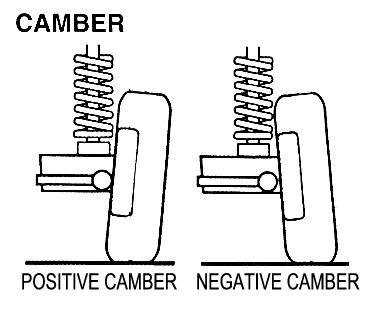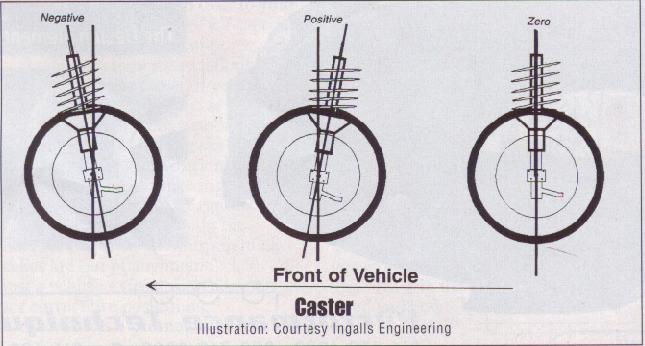Friday, November 12, 2010
Wheel geometry
Zeker met oog op de huidige Hella Flush hype is het niet onverstandig om uit te leggen wat wielgeometrie nou precies inhoud. Nu zal iedereen wel weten dat negatieve camber betekent dat je wielen schuin staan, maar wat voor een nut heeft alles met oog op driften en timeattacken? Wat voor een setup past het beste bij jou auto? En hoe valt alles te meten?
Laten we eerst maar beginnen bij de bekendste:
CAMBER
Camber is probably the most familiar suspension term to owners. It is the angle of the wheels relative to the surface of the road, looking at the car from the front or rear. Imagine a vertical line through the middle of the wheel. 0 degrees of camber is when this imaginary line is perpendicular to the road. Positive camber occurs when the top of the wheel is tipping away from the wheel arch. Negative camber is when the top of the wheel is tipping towards the wheel arch.
The camber setting applied to a car is done on a flat surface, at rest, with the correct ride height applied to the car. Ideally the car will also be corner-weighted to ensure that the static load on each wheel is as balanced as possible. Cars do not run an ideal static camber of 0 degrees because during cornering, the suspension loads result in deformation and an increase in positive camber. The dynamic camber becomes more positive as a car corners.
To combat this effect and ensure that as much of the tyre is in contact with the road surface during cornering, cars are always setup with negative static camber to compensate for the changes in camber during cornering. Too much negative camber will reduce straight line grip under braking.
CASTOR
Castor is a little more difficult to understand. Looking at the car side-on, imagine an axis line drawn through the steering axis of the wheel, so on a car with a McPherson-strut this line would be straight along the vertical axis of the strut. Positive castor occurs when the top of the axis line tilts more towards the rear of the car (the green line in the diagram). Negative caster is the opposite (the red line). The benefit of positive caster is that it provides good self-centring of the steering, allowing the car to travel in a straight line without constant holding of the wheel. Increasing negative caster will increase steering effort, weight and feel at the expense of self-centring.
TOE-IN & TOE-OUT
Toe is the measure used to determine the position of the wheels in relation to the body of the car. Looking at the car from above imagine lines through the middle of the wheels in the direction of travel. Toe In occurs when the front of the wheels point towards the car (the red lines), where as Toe Out occurs when the wheels point outwards from the car, as shown in the green lines. Toeing in gives more stability, but increased tyre wear.
Toeing out gives less stability but quicker direction changes. Ideally a car should run parallel toe, but deformation in suspension under load usually results in toeing in the rear to retain stability under direction changes, and toeing out the front to allow direction changes to happen faster. Most road cars would run with toe-in at the front.
When your car enters a corner, the body will start to roll. The effect of this is to cause the wheels of the car to lean in the opposite direction to cornering direction of the car. This causes the wheels to increase their camber in a positive direction, reducing available grip and hence making the car less stable. Negative camber must be used when a car is setup at rest to compensate for the increased positive camber that occurs in cornering. How much negative camber depends a lot on your individual driving style, the type of tyre being used, the roads you drive on etc.
The simplest way to determine how much negative camber to use is to drive on an example set of roads or on circuit depending on what you are setting the car up for, then measure temperatures across the width of the tyre. If there is too little negative camber, the outer edges of the tyre will be too hot as they are being overworked. Adjusting the camber until there is an even spread will ensure the best cornering grip and the longest tyre wear. There is a trade-off here though. The better the cornering grip, the worse the straight-line grip. This particularly affects braking and wet weather handling.
Another aspect of negative camber is that it creates a force on the wheels called camber-thrust which improves straight line stability. Also in cornering, the inner wheel will lift from the ground partially (or sometimes completely!). The camber-thrust will then cause the car to make a sharper turn due to the force pushing the car inwards, which results in better cornering. Car designers generally aim to have at least 0.5 degrees of negative camber with the suspension compressed when the car is cornering. This means that the negative camber at normal ride height will become more negative when the suspension compresses, while the effect of body roll as we have seen above will reduce that negative camber. Get the balance right, and there will still be some negative camber left for good corner grip, better steering and improved thermal response as the tyres heat-up faster. All of this is of course good for even wear on the tyres.
In an ideal world, tyres would always sit perpendicular to the road under all circumstances, but with road cars, or race cars based on road cars, this is just impossible to achieve as you have to have a certain amount of suspension travel, which results in softer suspension and inherent body roll. We also need to be economical with our tyres in the real world, unlike race cars that change tyres every hour or so! Hence, finding that happy compromise, which normally lives somewhere between 0.5 and 2.5 degrees of negative camber.
Camber is notoriously difficult to adjust, often being set by bushes and spacers, and due to manufacturing tolerances can be wildly out and different side-to-side. Using camber-plates and adjustable suspension components is the easiest way to a fully adjustable camber setup. It is also useful for people who use their cars on road and track as it enables them to run more camber for track days for better tyre wear, more grip and lots more fun!
Castor only applies to the front wheels as is used for a number of things including straight-line stability and self-cantering of the steering. A shopping trolley is a good metaphor for understanding the effect of castor. The front wheels of a shopping trolley have positive castor, and will go in the direction that you push the trolley. If you turned these wheels around 180 degrees, they would have negative castor, making it difficult to push and very unpredictable regarding which direction it will go in!
The more positive castor you run, the better the steering feedback at the wheel. Again this is a trade-off, as too much positive caster will make the steering very heavy in use. It will also cause the inner wheel to rise and the outer wheel to drop resulting in the transfer of weight from the inner wheel to the outer wheel when cornering, resulting in a loss of steering feel. The more positive castor you run, the less the steering will self-centre.
Castor is really difficult to adjust on a road car and the use of camber plates is a must as these include castor adjustment.
Toe has 3 major effects on our car: Tyre wear, straight line stability and corner-entry ability. The best tyre wear is achieved with completely parallel tyres – 0 degrees of toe. However, this is not the best for straight line stability or cornering ability! Front wheel drive cars have a tendency to under steer, so inducing some over steer with some applied toe-out will improve handling.
Too much toe-in and the tyres will tend to wear prematurely on the inner edges through scrubbing. Conversely, too much toe-out will see the outer edges wear in the same way.
Steering response is improved by toeing out. Straight-line stability is improved by toeing in! On racing cars, the scrubbing effect of toe can be used to help get tyres up to temperature quickly, for example if racing in cold conditions, which will provide more grip at the expense of tyre wear.
Road cars are nearly always set-up with toe-in to ensure good straight-line stability at the expense of better cornering. Race cars are normally setup with toe-out at the front, sacrificing straight-line stability in the pursuit of good cornering ability.
If the rear suspension is fully independent, then toe will also apply to the rear wheels, with similar effect to the front wheels.
There is a concept of static and dynamic toe, particularly on front wheel drive cars and rear wheel drive cars with independent suspension. When torque is applied to the driven wheels, they attempt to pull themselves forward, which inherently causes the wheel to toe-in. It is dependent on the suspension as to how much extra toe-in will result. The effect is more noticeable on road cars as they have much softer rubber bushings in the suspension joints to give good NVH (Noise, Vibration, and Harshness) characteristics. However, these bushings sacrifice precision of handling due to the lack of rigidity in the suspension subsystems.
Summary
As you can see, Camber, Castor and Toe are all of huge importance to the good handling of a car. In fact we would say that a well-setup standard car will always be superior to a poorly setup car with aftermarket suspension components. A good starting point for any setup is the manufacturer’s recommended factory setups, at the outer edge of the tolerances (e.g. maximum negative camber in tolerance). From there it really is one of driver preference and driver style coupled with the needs of the tyres. There are so many elements to suspension setup and so many components that can affect the overall handling including tyre compound, tyre pressure, bush material, suspension geometry, ride height, corner weight, bump and rebound setting, spring rate, centre-of-gravity and so on. Hopefully we have given you an insight into the importance of a proper setup and some understanding into what Camber, Castor and Toe are all about!
klik om bericht in het nederlands te lezen
Labels:
camber,
caster,
suspension




